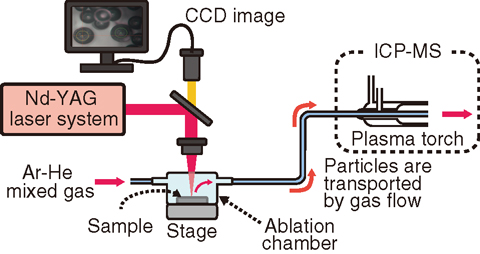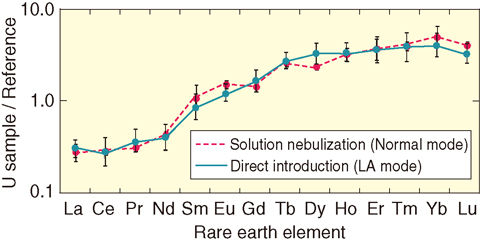
Fig.4-18 Simplified sample preparation achieved by laser ablation technology for ultratrace analysis of rare earth elements

Fig.4-19 Basic principle of the LA system

Fig.4-20 REE pattern obtained by laser ablation ICP-MS
Rare earth elements (REEs) comprising Sc, Y, and 15 lanthanides behave as a coherent group over geological and industrial processes, showing a distinctive pattern unique to their origin. The REE patterns found in uranium (U) ores and their refined products can be a reliable indicator of the origin attribution of U. This is a remarkable property in terms of the regulation of nuclear materials. In this study, a rapid and reliable analytical technique based on inductively coupled plasma mass spectrometry (ICP-MS) combined with a solid sample introduction system was developed for obtaining REE patterns.
ICP-MS has been a promising technique for determination of ultratrace amounts of REEs. However, interferences caused by isobars and molecular ions that have the same mass-to-charge ratio as a target isotope can be a definite factor in misleading measured values. In the determination of REEs, barium (Ba) may cause interferences by forming several barium oxides (e.g., 135Ba16O to 151Eu) within the plasma. The formation of such oxides is effectively attenuated by the direct introduction of a solid sample using laser ablation (LA) technology. Liquid sample introduction, which is typical in ICP-MS analysis, may induce the formation of oxides in the plasma. Ba in the sample solution can be combined with 16O of H2O molecules in an aqueous solution. In the developed method, ultratrace levels of the REE in a U-bearing sample solution (U standard solution) were adsorbed into cation-exchange resin particles to concentrate the REE into a solid phase and to remove U along with other coexisting elements. Then, the REEs adsorbed in the resin particles were directly measured with LA-ICP-MS, resulting in an efficient and interference-free measurement (Fig.4-18). In the LA mode, fine particles generated by evaporating the sample surface were efficiently transported by an Argon (Ar)-Helium (He) mixed gas flow (Fig.4-19). The REE pattern obtained through LA-ICP-MS analysis of the U-bearing sample agreed within uncertainty with that obtained through the conventional technique based on the nebulization of the REE-purified solution (Fig.4-20).
The developed method is applicable to the fingerprinting of nuclear materials, or nuclear forensic analysis, providing practical information for specifying interdicted nuclear materials.